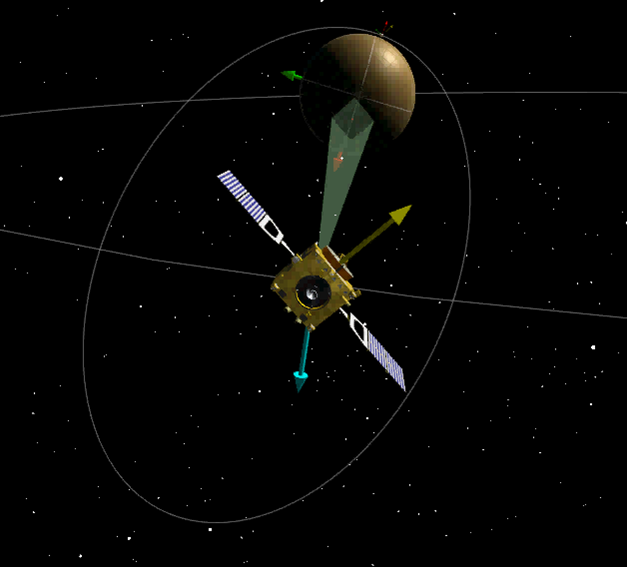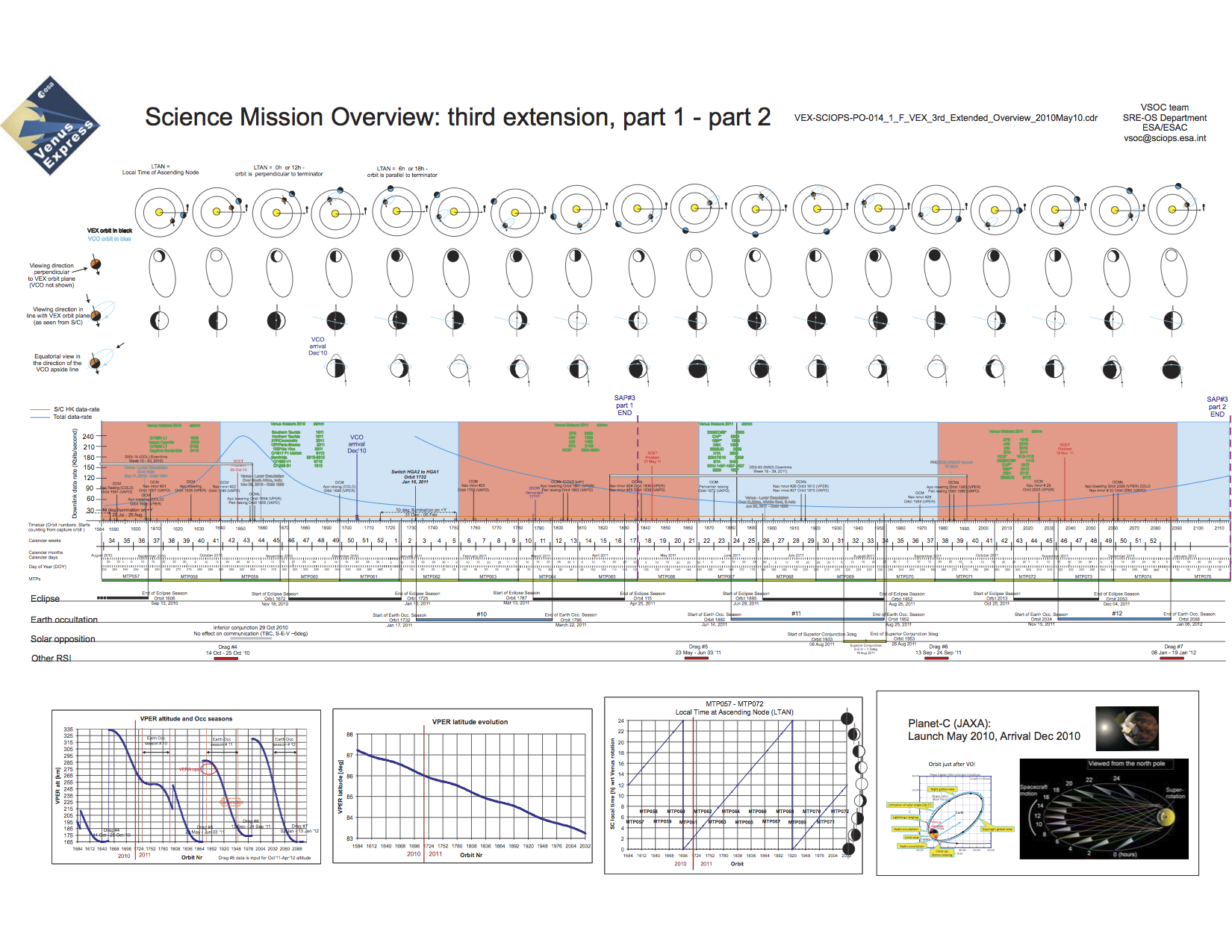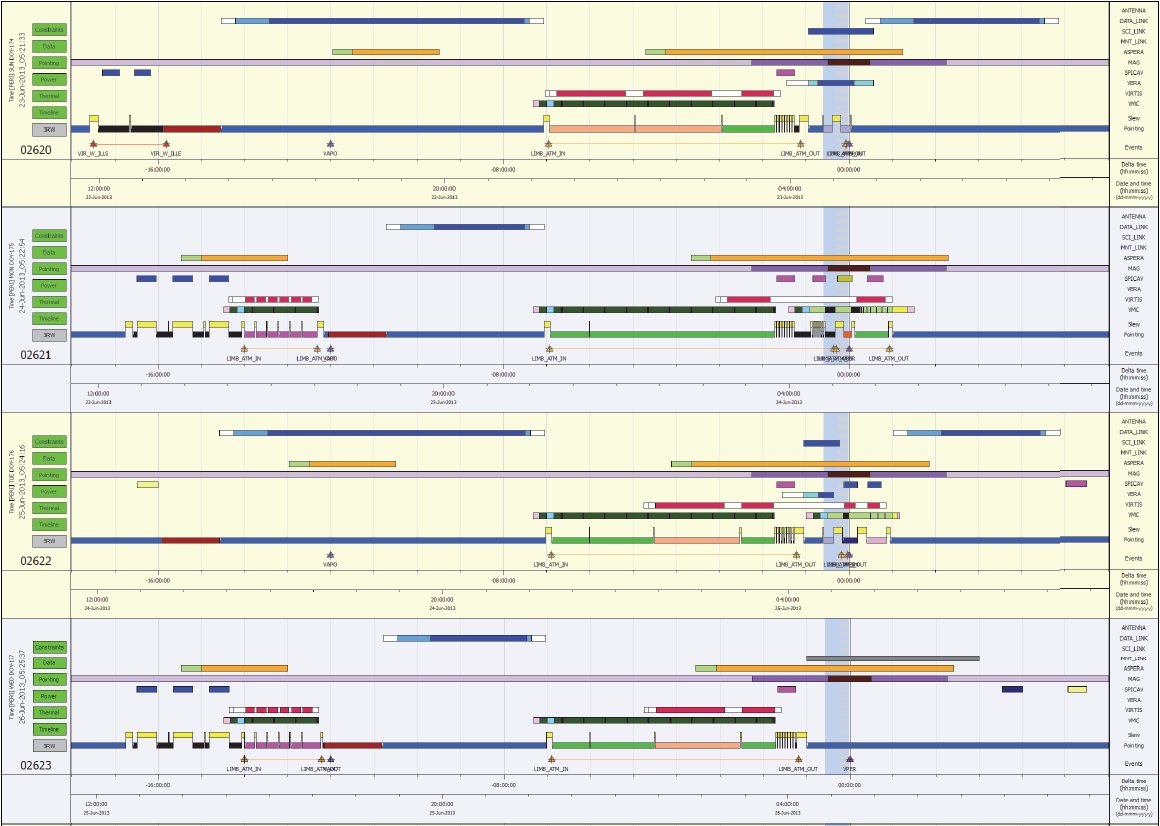vex-planning - PSA
Venus Express Science Operations

The science operations information provides an insight into the science planning activities for Venus Express, with special focus in describing the science operations context in which the archived science data available in the archive have been acquired. Learn more about the science operations concept...
Science Operations Information
Two key sets of documents describe the observations performed by Venus Express since the beginning of the mission: the Observation Tracking Table and the Science Activity Plan. In addition you can find a spreadsheet file that correlates the orbit numbers with date and day of year
Observations Tracking Table
This table contains a a list of all planned observations across the mission.
 Download the Observations Tracking Table
Download the Observations Tracking Table
A detailed description of the original Venus Express modes of observations is provided in the Science Cases document.
Science Activity Plans
These documents (in the table below) describe, for each phase of the mission, the science objectives, the specific requests from the instrument teams and the scientific activities planned. The science posters provide a graphical representation of each science activity plan.
Note that the SAP should not be used to identify detailed orbit-by-orbit observation schedules as these are subject to change during the detailed (MTP and STP) planning process.
List of Science Activity Plans and Posters
| Mission Phase | Science Activity Plan and Poster | Start MTP [ Date; Orbit ] | Stop (MTP/Date/Orbit) |
|---|---|---|---|
| Nominal | Download: SAP | Poster | MTP001 [ 7-May-2006; 16 ] | MTP019 [ 20-Oct-2007; 547 ] |
| Extension 1 (EXT1) | Download: SAP | Poster | MTP019 [ 3-Sep-2007; 520 ] | MTP040 [ 3-May-2009; 1035 ] |
| Extension 2 (EXT2) | Download: SAP | Poster | MTP041 [ 31-May-2009; 1136 ] | MTP056 [ 21-Aug-2010; 1583 ] |
| Extension 3 (EXT3), Part 1 | Download: SAP | Poster | MTP057 [ 22-Aug-2010; 1584 ] | MTP065 [ 30-Apr-2011; 1835] |
| Extension 3 (EXT3), Part 2 | Download: SAP | Poster | MTP066 [ 1-May-2011; 1836 ] | MTP075 [ 4-Feb-2012; 2115 ] |
| Extension 3 (EXT3), Part 3 | Download: SAP | Poster | MTP076 [ 4-Feb-2012; 2116 ] | MTP087 [ 5-Jan-2013; 2451] |
| Extension 4 (EXT4), Part 1 | Download: SAP | Poster | MTP088 [5-Jan-2013; 2452 ] | MTP100 [ 4-Jan-2014; 2815 ] |
Science Operations Planning Concept
The science operations planning is divided into three parts: Long Term Planning (LTP), Medium Term Planning (MTP) and Short Term Planning (STP).
Long Term Planning (LTP)

The Long Term Planning is done one to two years in advance of the actual operation execution onboard. A Science Activity Plan (SAP) is written, for each phase of the mission, to establish the long term objectives of this period and the specific conditions applicable. Based upon the information in the SAP, planning posters are created (although not necessarily with the identical date/orbit coverage). These posters give a graphical overview of the main planning information.
Medium Term Planning (MTP)
The detailed science planning is done in 28 day increments (4 weeks). These Medium Term Plans (MTP) are created with guidance from the SAP. The planning is finished approximately 3 months prior to the start of the MTP planning period. The instrument teams provide with inputs to the Science Operations Center, that integrates all inputs and creates a conflict-free planning that optimizes the available spacecraft and ground resources. The final products are twofold: the spacecraft pointing requests, and the instrument commands files. These are sent to the VEX Mission Operations Center (VMOC) for validation with the rest of spacecraft commands.

All the MTP information is presented in 3 documents: the Master Science Plan (MSP), the Timeline (TL), and the Data Volume Spreadsheet (DV).
Each MTP period also had two other planning documents used extensively during the planning process: the timeline, and the data volume spread sheet. The data volume spread sheet details the planned data volume per orbit, per instrument, and allows this to be compared against the data downlink predictions.
1. The Master Science Plan (MSP) contains the detailed implementation of the science operations for each MTP planning period. The Master Science Plans include as well a wealth of data about the progress of the planning as it was done, and the post-execution analysis.
2. The TimeLine (TL) shows graphically what spacecraft pointing and instrument operations were planned for each orbit. These are graphical representations of the type of spacecraft pointing, manoeuvres and slews. For each instrument, the graphics indicate when the instruments were operated, and in which operating modes.
3. The data volume spread sheet (DV) details the available downlink capacity through the ground station infrastructure, and the planned data volume per orbit and per instrument. It is used to validate and optimise the instrument acquisition and the onboard memory use.
Short Term Planning (STP)
The STP process allows a final refinement of the instrument commands before execution onboard. Two weeks prior to execution of the command files, the instrument teams have the opportunity to modify their instrument commanding created during the MTP process. This allows either recent unexpected events or the refined orbit knowledge to be taken into consideration in the instrument operations. The instrument commanding files are therefore iterated one last time. For ensuring that the resources are not surpassed at this late stage, and based on operational safety, the teams are asked to provide modifications but with certain limitations such as not to increase power consumption or data volume, and to maintain the operations in the allocated observation window.
After this, the final commands are delivered to the Flight Control Team for upload and execution in the spacecraft.
- Removed a total of (3) style float:left;
- Removed a total of (1) style float:right;
- Removed a total of (1) style padding:0;
- Removed a total of (1) border attribute.








































 Sign in
Sign in
 Science & Technology
Science & Technology